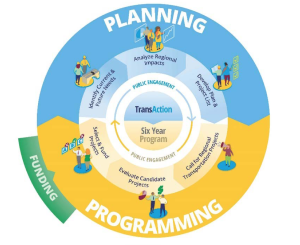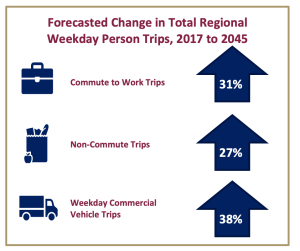 Don’t wait! NVTA Survey ends September 18.
Don’t wait! NVTA Survey ends September 18.
FABB encourages local riders to take the NVTA TransAction Survey (see links below) before the 18 September deadline. The is an infrequent opportunity to Speak Up in support of bicycling in long-term transportation planning. Given the increasingly obvious impact of climate change and the rising toll of highway fatalities, we need to raise our voices in support of serious planning to expand safe and reliable bicycling and other multimodal transportation options to reduce the number of vehicle miles driven in our region.
The NVTA TransAction survey consists of ten questions and does not take much time to complete. You can find the form here for English, Spanish, and Korean.
The first question asks how you heard about the plan, and, if you heard about it from us, please enter “Fairfax Alliance for Better Bicycling social media.”
Question 2 seeks comments on the Transaction Plan Document which summarizes travel conditions, challenges and opportunities in 2045 and the plan’s projected impact on improving travel. FABB suggests responses such as:
- The NVTA plan says the right things and has the right goals and values. But, the accompanying project list still has a “more of the same” transportation planning aspect that favors roads over multimodal transportation alternatives.
- The plan appears to include only seven specific protected bike lane projects on the list that runs to 2045. This is a serious missed opportunity to do more, faster, to improve active and multimodal transportation.
- The plan should prioritize the funding of bicycling and other multimodal transportation options in its next Six-Year Program as cost-effective and responsive means to achieving NVTA goals and values.
- By not doing more to advance transit and multimodal transportation alternatives more rapidly, the plan willing be relying on past approaches that have repeatedly failed to address congestion, CO2 emissions, pollution, and the need to reduce vehicle miles traveled.
- While the increase in projects involving trails, shared-use paths, and protected bike lanes is laudable, the plan and project list suggest that many are tied to lengthy road projects or major transit hub projects rather than rapid, short-term efforts to create the type of bicycling and walking infrastructure that could have an immediate impact on reducing congestion and pollution.

NVTA Goals and Core Values
The third question asks if the the TransAction Plan achieves its goals of Mobility, Accessibility and Resiliency. FABB thinks the correct response is “disagree” and suggests comments such as:
- Transit project descriptions leave unanswered questions about how infrastructure improvements might enhance overall performance of the multimodal transportation system beyond accessibility and possibly resiliency.
- Plans should describe how transit will be made more affordable and reliable to induce commuters and others to use active transportation to exploit multimodal options.
- Plan does not address secure and adequate bicycle parking, which will be essential to ensuring that riders can make use of major transit hubs, such as Metro or VRE stations.
Question 4 asks if the plan addresses the three NVTA core values of Safety, Equity and Sustainability. Despite the plan’s improvements over past transportation approaches, FABB “disagrees” that the plan represents those core values. FABB suggests providing additional comments such as:
- Adding funding and greater prioritization of bicycle infrastructure will more rapidly achieve NVTA values and goals.
- The plan’s continued emphasis on expanding highway lanes and incentivizing more motor vehicle traffic undercuts its other attempts to promote transit and multimodal options.
- The plan’s emphasis on roadways seems more likely to induce new traffic congestion with more lanes and tolls, developments that have not previously contributed to any of the three core values.
Question 5 requests feedback on specific Transaction Projects. FABB encourages riders to download and search the list for projects where you ride and share your ideas for improving the proposal. Please include the project ID number with your comments. For example:
- General: Descriptions of proposed bicycle improvements as part of larger multimodal improvements at Metrorail stations should be as detailed as those given for Project 12 Herndon Metrorail Multimodal Improvements.
- General: All proposed multimodal improvements for transit hubs should include secure bicycle parking (Project IDs: 12, 66, 70, 87, and 195).
- Project 445 Route 309/Glebe Road: McLean to Ballston Bike Connections. Route 309 would require extensive widening to add low-stress bicycling infrastructure between McLean and Kirby Road. A better connection that could link in part of Tysons and could be added using existing wide streets in all but a few spots would be to install protected bike lanes along Great Falls Street (Route 694) between Route 123 Dolley Madison Boulevard and the W&OD Trail, which connects to the Custis Trail just past the East Fall Church Metro Station. This project should be a high-priority.

Fulfilling NVTA goals and values means replacing car trips with other transportation options. The TransAction plan should do more, faster to promote bicycling, especially for short, non-commute trips.
Question 6 asks for comments on three scenarios used in developing the TransAction Plan, a Post-Pandemic “New Normal,” the adoption of new technology, and more incentives/pricing (tolls and express lanes). FABB suggests responses such as:
- Express lanes appear to benefit the few while still creating congestion and the inevitable choke points. Increase tolls promote cut-through traffic that ruins some neighborhoods and poses a danger to pedestrians and bicyclists on local streets. In short, NVTA should emphasize getting people out of cars, rather than advantaging some motorists who can afford express lanes and disadvantaging other road users and nearby residents.
- NVTA plans should promote all engineering, technological and policing efforts to reduce or eliminate the post-pandemic normal of reckless and distracted driving, especially speeding, which, as the plan points out, is behind most delays and the threat to life on regional highways and increasingly local streets.
Question 7 requests comments on desired additions to the long-range transportation plan that were included. FABB recommends emphasizing the following:
- Bike projects should specifically include parking infrastructure where appropriate.
- As mentioned earlier, NVTA plans should promote all engineering, technological and policing efforts to reduce reckless and distracted driving, especially speeding.
- The plan also needs to be clearer about projects to mitigate the impact of climate change, especially the impact of more flooding and storm damage that impedes roadways and affects traffic signals.
Question 8 seeks comments on the TransAction planning process and/or public participation. In general, FABB believes that the planning process was adequate but that the NVTA appears to have not fully incorporated the public responses from the 2021 survey.
Question 9 asks for ideas on making the NVTA review and public participation process easier for you. FABB has no suggested response.
Question 10 asks for any additional comments. FABB has no suggested response.
Please take the time to participate in the survey. Every voice added in support of better bicycling will help improve the region’s transportation plan. Please help make a difference for you and your family’s future.
